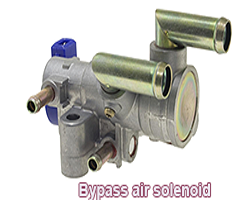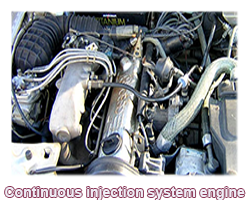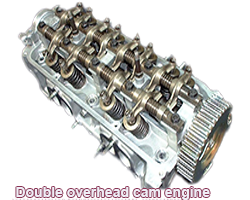
ADIABATIC ENGINE: Describes a type of internal combustion engine that is highly efficient in transferring combustion heat to those parts of the machine which are being cooled by the flow of anti-freeze coolant, allowing an even temperature to be maintained in the engine.
ALL-ALLOY ENGINE: Describes an internal combination engine block, crankcase, cylinder head, and sump produced using a light alloy material.
ASPIRATED ENGINE: Describes a type of engine whose power is drawn from a cylinder by suction, creating a vacuum in the cylinder to bring in air.
AXIAL ENGINE: Describes a type of turbine engine fitted with an axial-flow compressor.
BALANCED ENGINE: Describes an engine where all the reciprocating parts such as pistons and connecting rods are adjusted to the same weight.
BYPASS AIR SOLENOID (BPA): Describes a device used to control the idle speed on some fuel-injected vehicles
COMPRESSION: Describes the essential factor in an internal combustion engine (fuel, air, proper proportion of mixture, compression, timing, spark).
COMPRESSION: Describes the squeezing of the fuel-air mixture in the cylinder of any engine, making the process of combustion more effective and increases engine efficiency.
COMPRESSION CHECK: Describes the procedure of testing the compression in all the cylinders at cranking speed. All plugs need to be removed to carry out the check, and the compression gauge placed in one plug hole, with the throttle cracked wide open, and the engine cranked until the gauge no longer climbs. Carrying out a compression check is necessary to ascertain the valves, rings, and cylinders' condition.
COMPRESSION LEAKAGE: Describes the situation in an internal combustion engine when some gases escape past the piston, usually due to the rings or cylinder walls being worn.
COMPRESSION RATIO: Describes the procedure in an internal combustion engine, where, when the piston is at the bottom of its travel (BDC), the volume of the cylinder is measured (suppose the volume is X). Then the piston is placed at the top of its travel (TDC), and the volume of the cylinder is measured (suppose this volume is Y). The compression ratio is a comparison of these two values expressed as X: Y.
COMPRESSION RING: Describes the ring that surrounds the piston and fits in a grove in the piston, designed to seal the burning fuel charge above the piston to transfer heat from the piston into the cylinder walls and subsequently to the water jacket surrounding the cylinder.
COMPRESSION STROKE: Describes the second stroke of the four-stroke cycle in an internal combustion engine, in which the piston moves upward from bottom dead centre to top dead centre, compressing the fuel-air mixture.
CONSUMPTION: Describes the act of using up an amount of fuel when joined with air and changed into other substances such as Carbon Dioxide and Carbon Monoxide.
CONTINUOUS INJECTION SYSTEM (CIS): Describes a mechanical fuel injection system designed and manufactured by Bosch, used on many German vehicles. In a CIS system, the fuel injectors are always open while the fuel pressure determines the amount of fuel sprayed into the system
CONTROL PLUNGER: Describes a type of device that is part of the vehicle's fuel injection system that moves up and down to provide the correct amount of fuel to each cylinder.
CONTROLLED COMBUSTION SYSTEM (CCS): Describes a system used to control and reduce unburned hydrocarbon emission from the engine exhaust.
DOUBLE OVERHEAD CAM(DOHC): Describes an engine fitted with two camshafts located above the cylinders, with one driving the intake valves and the other operates the exhaust valve.
DIESEL ENGINE: Describes an internal combustion engine powered by diesel that does not use a carburettor or an ignition system. Instead, diesel oil is injected into the cylinders when the piston is compressed. The Diesel engine took its name from Rudolf Diesel, its inventor.
DUAL FUEL ENGINE: Describes an internal combustion engine fitted out to operate using two different fuels such as gasoline and Liquid Propane Gas.
All Categories
- Home Page
- Mechanics
Mechanics
Back- Camshaft
- Carburettors A-C
- Carburettors D-F
- Carburettors H-M
- Carburettors R-W
- Clutch B-C
- Clutch D-W
- Cooling System A-C
- Cooling System D-F
- Cooling System H-W
- Crankshaft A-C
- Crankshaft D-W
- Cylinder Head
- Engine A-D
- Engine E
- Engine F-L
- Engine M-S
- Engine T-X
- Filters
- Fuel Control Systems A-E
- Fuel Control Systems F
- Fuel Control Systems M-S
- Gearbox A-D
- Gearbox E-G
- Gearbox H-R
- Gearbox S-W
- Oil Control Systems C-W
- Oil Control Systems
- Pistons
- Auto Electrics
- Brakes,Suspension and Steering
Brakes,Suspension and Steering
Back- Axles
- Brakes A-B
- Brakes E-D
- Brakes FL
- Brakes M-R
- Brakes S-Y
- Differential
- Drive Systems
- Exhaust Systems A-D
- Exhaust Systems E
- Exhaust Systems F-Y
- Hydraulics
- Shock Absorbers
- Springs
- Steering A-R
- Steering S-V
- Suspension A-H
- Suspension I-R
- Suspension S-W
- Tires A-F
- Tires G-B
- Tires S-W
- WheelsA-I
- WheelsI-S
- Wheels T-V
- Bodywork
- Exterior Trim
- Interior Trim
- Paintwork
- Parts and Fittings
- Tools and Equipment
Tools and Equipment
Back 



- Site Map
- Privacy Policy
- Contact Us


All you need to know on how to acquire, restore and maintain a Classic Car
Step back in time to the renaissance age of the UK and European Car Industries
> All that is happening NOW in the world of classic cars.
Step into the golden decade of the UK and European Car Industries
and catch up with all the latest news and features.
Sign up for a Classic Car Info Twitter account
ae4









